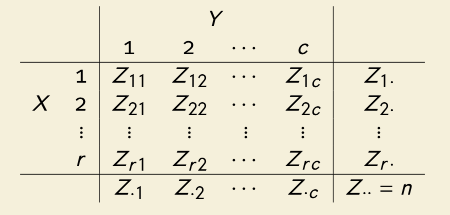- Chap 7 - Introduction to Statistical Inference
- Exercise 5
- Chap 9 - Point Estimation
- Exercise 6
- Chap 10 - Hypothesis Testing (I)
- Exercise 7
- Chap 11 - Hypothesis Testing (II)
- Exercise 8
This is my course note taken in Chinese.
Chap 7 - Introduction to Statistical Inference
Population
- 未知
Sample
- 已知、随机、iid
Parametric Models
- 我们假定总体符合一个分布$F(\cdot ; \theta)$,这个分布是我们熟悉的分布(比如:norm),而我们不知道的是分布的参数$\theta$。
- 在参数模型中,我们倾向于去估计这个$\theta$,一旦这个参数被确定下来,我们就知道了该分布的所有信息。
Statistic
- 对于随机的样本定义的一个已知的函数
- 已知意味着,函数表达式中不能出现未知的$\theta,\mu$等,而只能出现已知的$X_i$
Fundamental concepts in statistical inference
Point Estimation
-
评价estimator的指标:
-
$\mid \hat \theta-\theta\mid$
-
Mean Square Error
-
The Standard Error an estimator for the standard deviation ${Var(\hat \theta)}^{1/2}$
-
Consistency
-
- estimator的渐近正态性
Confidence Sets
-
目的:表示估计的不确定性
-
Confidence Interval
-
含义:盖住真值的概率(注意主动被动)
-
Confidence level: $1-\alpha$
-
渐近正态的estimator成立置信区间
-
在这一章中讲的置信区间都还比较简单,只是利用CLT去构造一个正态的。
-
Hypothesis testing
- 问题:是否能够有足够的证据拒绝零假设
Nonparametric models and Empirical distribution functions
Nonparametric model
- 并不假定F为何种分布,而是直接对于F进行估计和检验
Empirical Distribution Functions
- $I(X_i \le x)$是属于Bernoulli分布的一个随机变量,$p=F(x)$
Exercise 5
构造estimator并求其相关性质
- 先按照该统计量在分布中的定义和性质写出他的原表达式(e.g. Bernoulli的方差是p(1-p),均值是p)
- 这里可能会用到均值和方差的那些计算公式(e.g. $Var(X+Y)=Var(X)+Var(Y)+2Cov(X,Y)$)
- 然后利用plug in
经验分布
- 天生就适合与Bernoulli相结合,因为$I(X_i \le x)$定义上就是个Bernoulli的分布
- ==分清楚Bernoulli和Binomial==
Chap 9 - Point Estimation
- 目的:估计参数模型中的参数
Methods of Moments Estimation
-
k阶矩(Moment)
-
k阶样本矩
-
MM estimator $\hat \theta$
-
需要记住的两点
-
$\hat \sigma^2$的有偏性和$S^2=\frac{1}{n-1} \sum_{i=1}^n(X_i - \bar X)^2$的无偏性
Maximum Likelihood Estimation
Likelihood
-
区分:likelihood function L 和 density function f
- 一个是参数$\theta$的函数,一个是样本x的函数
-
定义
Maximum Likelihood Estimation
- 注意“截断性”的那种条件,比如要求$y\ge \theta$的话那么就要在Likelihhod的表达式中加上$I_{{(\theta,\infty)}}Y_{min}$
- Invariance property of MLEs:当出现1-1的映射$\phi=g(\theta)$的时候,则$\phi$的MLE为$\hat \phi=g(\hat \theta)$
Numerical computation of MLEs
- 目的:用迭代的方法去找到MLE
Newton-Raphson Scheme/Newton Method
- 如果只有一个参数$\theta$,那就是求二阶导,如果有多个参数的话就是求Hessian矩阵
- 初始值的确定是很重要的
The Fisher Scoring method
Differences between NM and FSM
- NM收敛更快
- 初始值对于FSM的影响更小
- 用法:一般都是先随便初始化一个初始值,用FS去找一个收敛值,然后把这个收敛值当成初始值去用NM。
Evaluating Estimation
- Note:SE只对无偏估计量有意义
Fisher Information
-
If $X=(X_1,\cdots,X_n)$ and X iid
-
如果只有一个参数,即$\theta$是标量
Cramer-Rao Inequality
-
一个统计量(也即样本X的映射)$T=T(X)$,$g(\theta)=E(T)$,对于任意的$\theta$
-
当无偏时,$T=T(X), g(\theta)=E(T)=\theta,g’(\theta)=1$
-
这代表了无偏估计量T的精度,为其求得了一个最小值$1/I(\theta)$。此时,T为Minimum Variance Unbiased Estimator(MVUE)。
-
对于有多个参数的时候,$Var(T)-I(\theta)^{-1}$为半正定矩阵。

Asymptotic Properties of MLEs
-
Consistency
-
Asymptotic normality

Exercise 6
求MLE及其性质
- 用分布的f去求likelihood function,然后取log连乘变加和,求导=0得到MLE。
- 求MLE的时候与之前一样,注意$0\le y \le \theta$截断的情况。以及有时候常数项可以不写出来。
- 得到MLE后再针对MLE去求一些相关性质比如bias,var,se甚至是分布$F(X)=P(\theta\le X)$等等。
- 分布的话,先求CDF再通过求导求pdf。
Information
- $I(\theta)=I_X(\theta)=\sum_{i=1}^nI_{X_i}(\theta)=nI_{X_1}$,不要漏掉n啊。
- ==求E的时候的积分太太太难求了!还有就是各种公式不要记混,参数是一维还是二维都要分清楚,求的是导数还是梯度,二阶导数还是Hessian都要分清==
Chap 10 - Hypothesis Testing (I)
General setting of hypothesis test
- Notice: Not reject $\not =$ Accept
- Reject $H_0$ if $p-value\le \alpha$
- 更极端的情况是相对于$H_1$而言的
Two types of errors
| $H_0$为真 | $H_1$为真 | |
|---|---|---|
| 拒绝$H_0$ | Type I error $\le \alpha$ | $\beta(\theta)$ |
| 不拒绝$H_0$ | Type II error=$1-\beta(\theta)$ |
The Wald test
-
前提:估计量满足渐近正态$(\hat \theta- \theta)/SE(\hat \theta)\rightarrow N(0,1)$
-
检验量:$(\hat \theta- \theta_0)/SE(\hat \theta)$
-
拒绝条件(注意单边双边

$\chi^2$ Distribution
Confidence Interval for $\sigma^2$
- 前提:$X\sim N(\mu,\sigma^2)$
- 检验量:$\sum_{i=1}^n (X_i-\bar X)^2/\sigma^2 \sim \chi^2_{n-1}$
t Distribution
An important property of normal samples
-
前提:$X \sim N(\mu,\sigma^2)$
-
已知:$\bar X=\frac{1}{n}\sum_{i=1}^nX_i,S^2=\frac{1}{n-1}\sum_{i=1}^n(X_i-\bar X)^2,SE(\bar X)=\frac{S}{\sqrt{n}}$
-
结论:==证明==
-
$\bar X \sim N(\mu,\sigma^2/n),(n-1)S^2/\sigma^2 \sim \chi^2_{n-1}$
-
$\bar X$和$S^2$独立
-
Accurate confidence interval for mean
看《概率论》书籍的补充【表格总结】
- t-test (one sample)
- Tests for normal means(two sample)
- pairwise comparison - one sample t-test
- two sample t-test
- the wald test (也可以针对多个sample适用)
==Most Powerful Tests and Neyman-Pearson Lemma==
Exercise 7
纯构造置信区间
- 分清楚$\sigma$已知未知,用正态还是用t
- $\chi$的自由度是多少
- 一个新的统计量构造置信区间的话要先求MLE
Chap 11 - Hypothesis Testing (II)
Likelihood Ratio Tests
-
适用:当$H_0$和$H_1$都为复杂域的时候
-
检验量: $\hat \theta$是全局上的MLE,而$\tilde \theta$是$H_0$成立时的MLE。
-
拒绝条件:$2\log (LR) > \chi^2_k(\alpha)$
Asymptotic Distribution of Likelihood ratio test statistic
$\varphi$是我们关注的参数,而$\lambda$是我们不感兴趣(却同样未知)的参数。$k=d-d_0$,d是$\Theta$的维度,$d_0$是$\Theta_0$的维度。
The permutation test
-
目的:测验两个分布是否一样。
-
前提:无前提假设,在处理小样本的时候非常有优势。
-
核心思想:将两个样本“合”在一起看分布。
-
检验量: 对于$A_{m+n}=(m+n)!$种排列都计算T,得到$T_1,\cdots,T_{(m+n)!}$
-
拒绝条件:
$\chi^2$ test
Goodness of fit test
-
目的:检验样本是否服从某一给定的分布(分布已知,但参数未知)。
-
形式:列表(frequency在这里是频数而不是频率。
-
步骤:首先估计参数(利用MLE),然后计算期望频数$E_i=np_i(\hat \theta)$

-
统计量:$T=\sum_{j=1}^k (Z_j-E_j)^2/E_j \sim \chi_{k-1-d}^2$
d为$\theta$的维数。
-
拒绝条件:$T>\alpha$
Test for independence of two discrete random variables
-
回顾:独立性的条件为$p_{ij}=p_i p_j$
-
步骤:在$H_0$成立的条件下,$\tilde p_{ij}=\hat p_i \hat p_j = \frac{Z_i}{n} \frac{Z_j}{n}$,由此可以计算出期望频数$E_{ij}=n\tilde p_{ij}={Z_i} \frac{Z_j}{n}$

-
统计量:$T=\sum_{i=1}^r\sum_{j=1}^c (Z_{ij}-E_{ij})^2/E_{ij}\sim \chi^2_{p-d}$
p为rc-1,d为r+c-2,所以$p-d=(r-1)(c-1)$
-
拒绝条件:$T>\alpha$